Scottish Sea Fisheries Statistics 2022
A National Statistics publication that provides detailed information on the tonnage and value of landings, fishing vessel characteristics and employment. Detailed supplementary excel tables and a pdf version of the publication are available in supporting documents.
2 Landings by Scottish vessels
In 2022, Scottish vessels landed 429 thousand tonnes of sea fish and shellfish with a gross value of £617 million (Table 8). Compared to 2021 there was an increase of four per cent in the real value of landings and a two per cent decrease in the tonnage landed. The increase in real value was driven mainly by demersal and shellfish species, although the value of pelagic species also increased.
In 2022, the higher fuel costs in response to the war in Ukraine looks to have led to Scottish vessels making less voyages to minimise costs (Table 27). Although this resulted in a small decrease in tonnage landed, the overall value landed increased due to market price increases.
Shellfish landed by Scottish vessels and included in this publication are crustaceans, molluscs and cephalopods. This includes species such as lobsters and crabs, which are commonly eaten in restaurants. The closure of the restaurant and hospitality sector in the UK and abroad during periods of 2020 and 2021 due to Covid-19 adversely affected the demersal and shellfish sector. In 2022, the higher fuel costs in response to the war in Ukraine also impacted these sectors, with the larger trawl and dredge vessels affected more than the less fuel intensive creel vessels.
Demersal fish are those which live close to the seabed such as cod, haddock and monkfish. Reduction of quota allocation to Scotland for species such as cod has also negatively impacted the demersal sector.
The pelagic sector are species found mainly in shoals in midwater or near the surface of the sea such as herring and mackerel. This sector is seasonal and generally operates with larger vessels. It was largely unaffected by the impacts of Covid-19, increasing in tonnage and value from 2019. Annual changes in quota allocation for pelagic species have a big impact.
Scotland's commercial fishing industry comprises a significant proportion of the United Kingdom fishing industry. Landings by Scottish vessels accounted for 62 per cent of the value and 67 per cent of the tonnage of all landings by UK vessels in 2022 (Table 25a).
Chart 1. The real value of the fish landed by Scottish vessels has decreased from a high of £735 million in 2016, to a low of £520 million in 2020 due to the impacts of Covid-19. The value has since increased to £617 million in 2022.
Total tonnage and value (adjusted to 2022 prices) of all landings by Scottish vessels, 2013 to 2022.
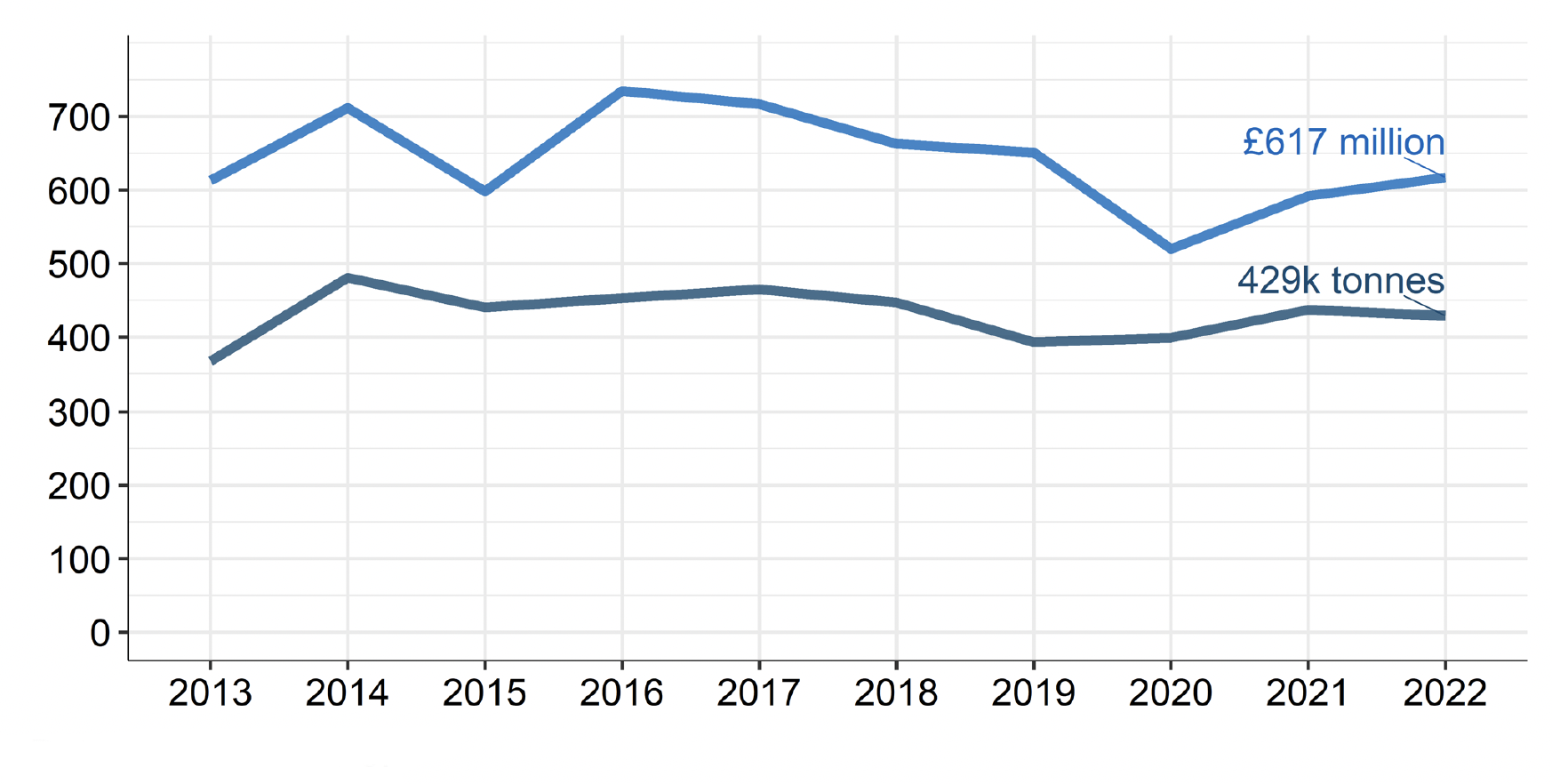
Data source: Table 3.
As can be seen in Chart 1, the long term trend for the tonnage of the fish landed by Scottish vessels has been generally stable, at around 400 thousand tonnes, since 2015.
2.1 Key species landed
The four per cent increase in the real terms value of landings by Scottish vessels, to £617 million between 2021 and 2022, was driven by an increase in the value of demersal and shellfish species. The real terms value of demersal landings increased by nine per cent, shellfish landings increased by five per cent and pelagic landings increased by one per cent compared to 2021.
The two per cent decrease in tonnage landed by Scottish vessels is attributed to an decrease in landings of shellfish and pelagic fish. Shellfish landings decreased by seven per cent by tonnage and pelagic landings decreased by three per cent. Demersal landings increased by six per cent.
Table 1. The real value of mackerel landings decreased by four per cent and tonnage decreased by six per cent between 2021 and 2022. The real value of Nephrops landings increased by 11 per cent but tonnage decreased by 14 per cent between 2021 and 2022.
Change in total tonnage and value of landings by Scottish vessels between 2021 and 2022.[1],[2],[3]
| Species | Tonnage 2022 | Tonnage change from 2021 (percent) | Value (thousands of pounds) 2022 | Value change from 2021 (percent) |
|---|---|---|---|---|
| Haddock | 26,851 | 33 | 33,998 | 11 |
| Monkfish | 11,989 | -5 | 35,078 | -2 |
| Cod | 6,863 | 17 | 25,562 | 21 |
| Whiting | 8,879 | -14 | 11,832 | -20 |
| Other demersal | 28,240 | -3 | 63,657 | 19 |
| Total demersal | 82,822 | 6 | 170,127 | 9 |
| Mackerel | 173,569 | -6 | 213,306 | -4 |
| Herring | 72,837 | 42 | 49,803 | 44 |
| Other pelagic | 47,005 | -29 | 11,370 | -26 |
| Total pelagic | 293,411 | -3 | 274,479 | 1 |
| Nephrops | 19,302 | -14 | 82,800 | 11 |
| Scallops | 16,675 | -5 | 31,742 | 1 |
| Edible crabs | 7,670 | -6 | 19,119 | -1 |
| Lobsters | 1,176 | -1 | 16,255 | -14 |
| Other shellfish | 8,180 | 8 | 22,590 | 12 |
| Total shellfish | 53,003 | -7 | 172,506 | 5 |
| Total | 429,235 | -2 | 617,112 | 4 |
Mackerel remained the most valuable species with £213 million landed, accounting for 35 per cent of the total value of Scottish landings. The decrease in mackerel tonnage in 2022 is in line with a decrease in available quota. Quota is the share of the fish catch allowed to vessels. Scottish vessels' landings accounted for just over four fifths (81 per cent) of UK mackerel landings by tonnage and 87 per cent by value.
Scottish vessels commonly catch a wide variety of demersal species, including more than a dozen species with landings that are worth over £1 million annually (Table 8). Monkfish was the most valuable demersal species and represented six per cent of the total value of Scottish vessels' landings and 21 per cent of the value of demersal landings in 2022.
Chart 2. Mackerel is the most common fish species landed by Scottish vessels by weight. 174 thousand tonnes of mackerel were landed in 2022, more than double the next most common species by weight, herring.
Scottish vessel's most commonly landed fish species by tonnes landed in the UK and abroad, 2022.
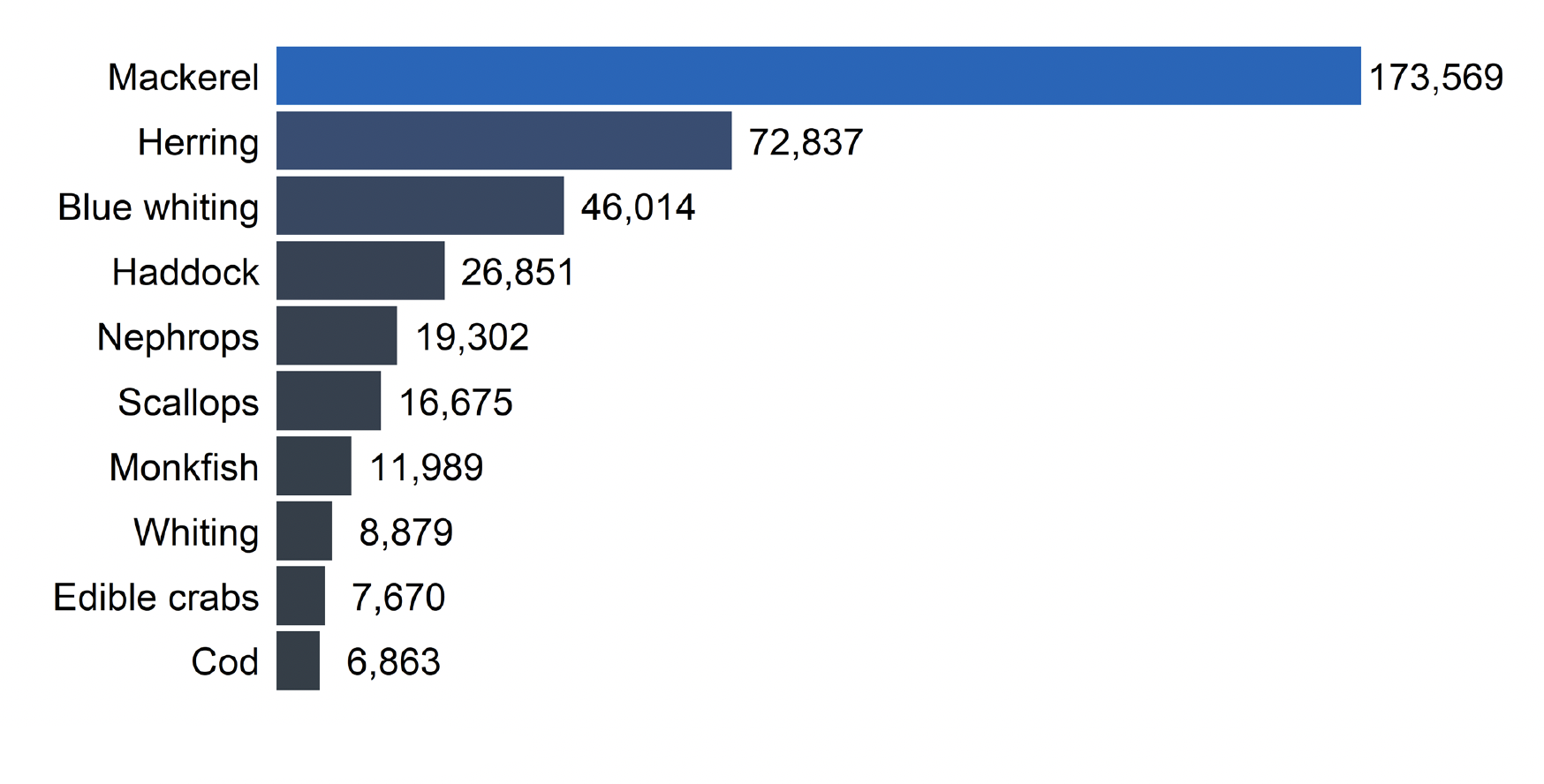
Data source: Table 8.
Chart 3. Mackerel is the most common fish species landed by Scottish vessels by value. £213 million of mackerel were landed in 2022, more than double the next most common species by value, Nephrops.
Scottish vessel's highest value landed fish species by thousands of pounds landed in the UK and abroad, 2022.
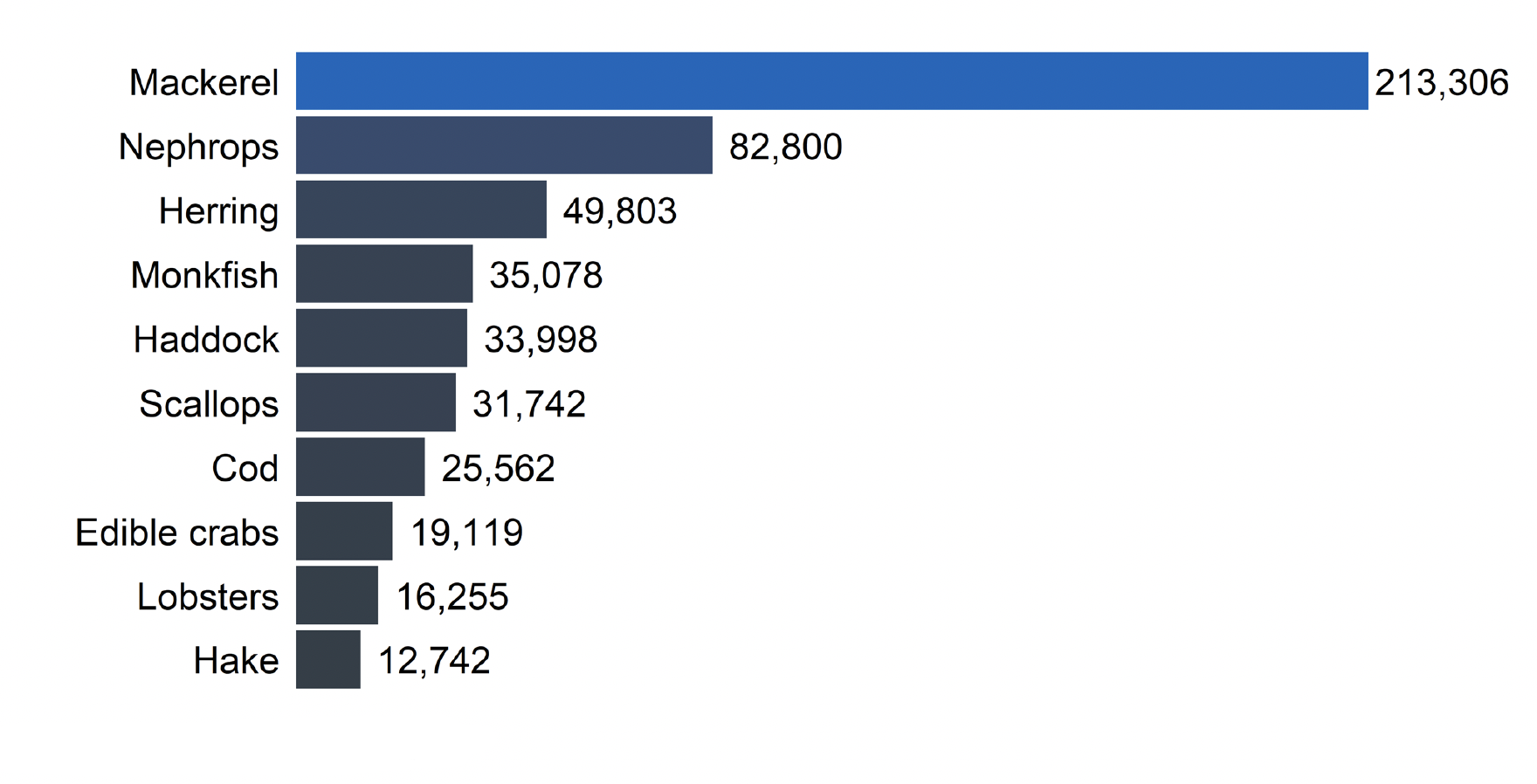
Data Source: Table 8.
Nephrops are the most valuable shellfish stock and the only shellfish species currently subject to quota. Scottish vessels fish for Nephrops by creeling and by trawling. Creeled Nephrops are often caught and exported live. Creeled Nephrops represent a smaller tonnage of landings, but attract an average price per tonne four times that of trawled Nephrops. Some trawled Nephrops are sold whole but the majority are sold as tails for turning into scampi. In 2022, 1,415 tonnes of creeled Nephrops were landed by Scottish vessels with a value of £16 million[4]. Eighteen thousand tonnes of trawled Nephrops were landed worth £67 million. These data are presented in Table 30c.
2.2 Long term sector trends
Over the past ten years 2013-2022, the tonnage of pelagic landings has increased by 45 per cent with real terms value increasing by 26 per cent. Pelagic landing tonnage is largely driven by the available quota (Tables 36a to 36d).
Compared to 2013, the tonnage of demersal landings fell by 19 per cent with real terms value decreasing by 14 per cent. Demersal landing tonnage is affected by available quotas, affecting some species, such as cod, more than others (Tables 36a to 36d). Over the period 2013 to 2022, the tonnage of shellfish landings fell by 15 per cent with real terms value decreasing by 12 per cent. It is uncertain whether the shellfish and demersal landings will return to 2019, pre-pandemic, levels in the near future.
Chart 4. Landings of pelagic species by Scottish vessels increased sharply from 203 tonnes in 2013 to 330 tonnes in 2014 before gradually decreasing to 234 tonnes in 2019. Pelagic landings then increased to 293 tonnes in 2022.
Tonnage of landings by Scottish vessels by species type, 2013 to 2022.
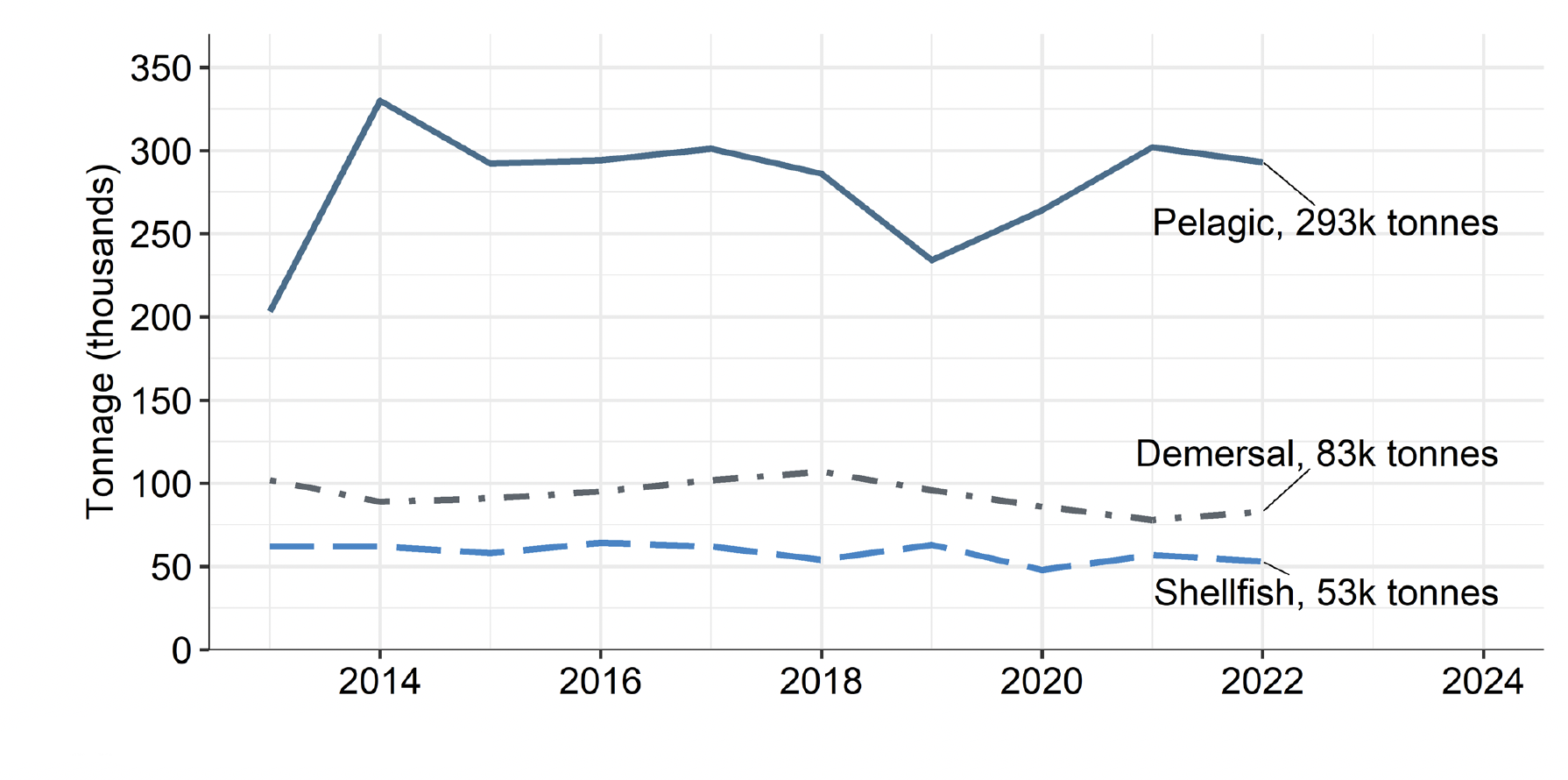
Data source: Table 3.
Chart 5. The real value of shellfish species landed by Scottish vessels increased from £195 million in 2013 to £233 million in 2017. The landed shellfish real value remained at similar levels until 2019 before decreasing sharply to £127 million in 2020. The real value of shellfish landings then increased to £173 million in 2022.
Value (adjusted to 2022 prices) of landings by Scottish vessels by species type, 2013 to 2022
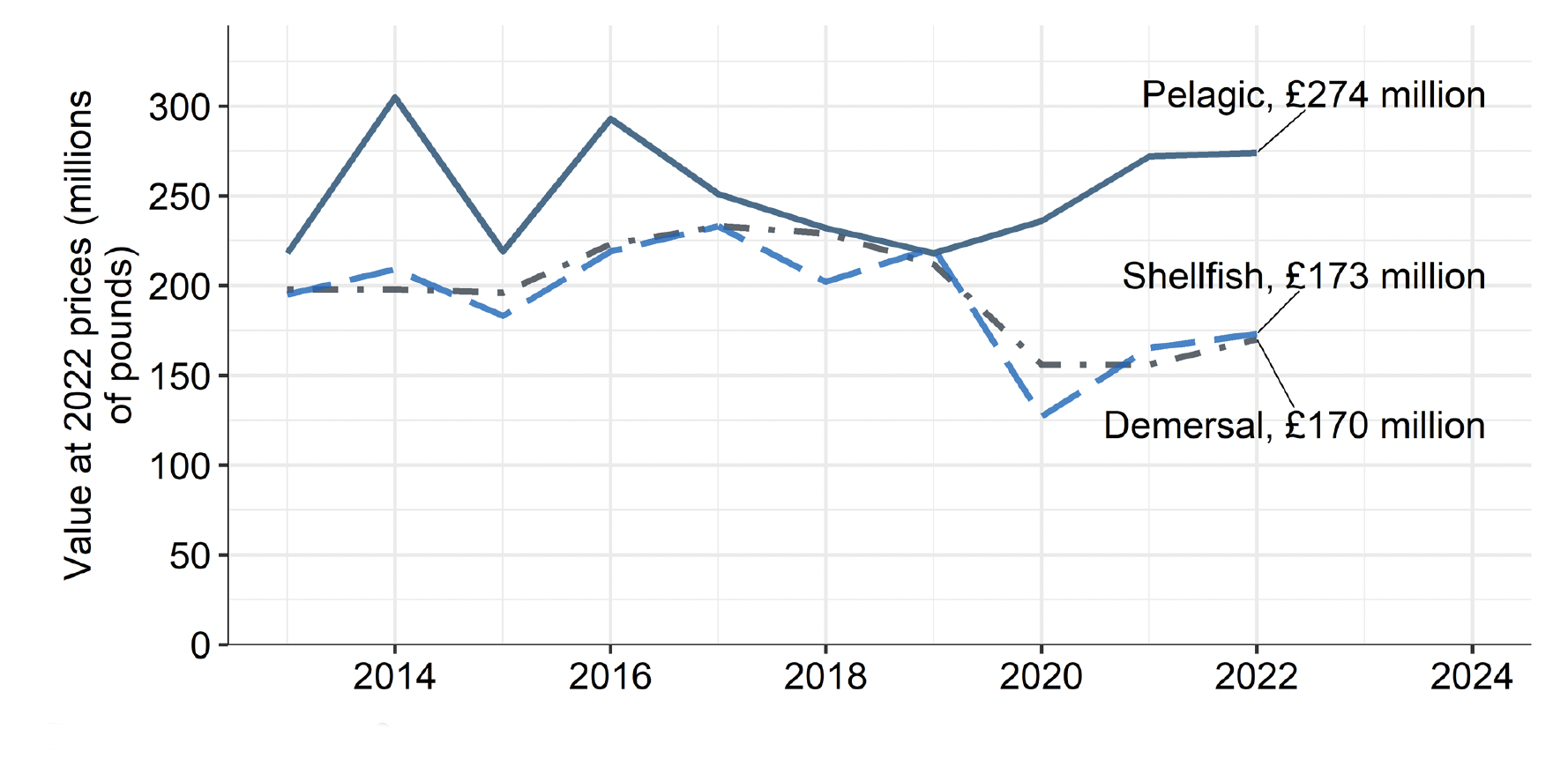
Data source: Table 3.
2.3 Fish prices
Scottish vessels land a vast range of different species throughout the year and they all achieve different prices at auction. The price achieved will vary by species, individual market, supply, demand, seasonality and the condition of the fish. Table 2 shows the average price per tonne for a selection of species landed by Scottish vessels.
Mackerel is the highest value species for Scottish vessels yet has a much lower price per tonne than many other species. It is the vast tonnage of mackerel caught that leads to the value being so high.
Lobsters have a high price per tonne yet a fairly low value compared to other main species. This is due to seasonality, lobster is not in season during several months of the year resulting in a lower tonnage landed throughout the year compared to other species. They are also considered a luxury food and tend to be purchased mainly by the hospitality sector.
Table 2. There is great variation in the prices achieved across the different species. Lobsters have the high price, at £13,827 per tonne in 2022, whereas herring has a low price, at £684 per tonne in 2022.
Change in price per tonne of selected species landed by Scottish vessels between 2021 and 2022[5][6][7]
| Species | Price per tonne 2022 (pounds) | Price per tonne 2021 at 2022 prices (pounds) | Price per tonne change from 2021 (percent) |
|---|---|---|---|
| Mackerel | 1,229 | 1,197 | 3 |
| Nephrops | 4,290 | 3,315 | 29 |
| Herring | 684 | 670 | 2 |
| Monkfish | 2,926 | 2,821 | 4 |
| Haddock | 1,266 | 1,506 | -16 |
| Scallops | 1,904 | 1,803 | 6 |
| Cod | 3,725 | 3,615 | 3 |
| Edible crabs | 2,493 | 2,367 | 5 |
| Lobsters | 13,827 | 16,002 | -14 |
| Hake | 2,564 | 2,399 | 7 |
2.4 Total Allowable Catches quota and uptake
Total Allowable Catches (TAC) are limits set at annual international negotiations for individual fish stocks and represent the maximum of each fish stock that can be caught. Up until 2020, while the UK was still a member of the European Union (EU) the majority of stocks were managed and fished only by EU member states. Member states access to management and fishing of stocks were based on a number of factors, including historic track record. The TACs for these stocks were set by the European Commission through internal negotiations between EU member states with an interest and based on independent scientific advice from ICES. The remaining stocks were managed and shared with other Coastal States: Norway, Iceland, the Faroe Islands, Greenland and Russia, with TACs for these set at separate negotiations. The amounts corresponding to this share, known as quotas, are shown at the UK and at the Scottish Producers Organisations' (POs) level in tables 36a to 36d.
Uptake of key commercial quota stocks by all Scottish vessels by tonnage and value landed are presented in table 37. In general, Scottish POs had high quota uptake in 2022 for key demersal and pelagic species. Uptake of mackerel stocks in the North Sea was 86 per cent and uptake of mackerel stocks in the West of Scotland exceeded quota[8].
For demersal stocks, uptake in the North Sea was generally high with cod quota uptake at 99 per cent and monkfish at 94 per cent. West of Scotland cod has a nil quota and is managed as a bycatch. The Scottish quota reduction for cod of 65 per cent between 2019 and 2022 led to an increased pace of quota uptake, reflecting the importance of this species to the domestic fleet.
The only shellfish species subject to quota is Nephrops. In 2022, Scottish PO quota uptake for North Sea Nephrops was 81 per cent and for West Coast Nephrops it was 67 per cent. This is 10 percentage points down compared to 2021 for the North Sea and two percentage points up for the West Coast.
2.5 Where Scottish vessels land their fish
Scottish vessels land their catches into Scotland, the rest of the UK and several countries abroad. In 2022, Scottish vessels landed 162 thousand tonnes of sea fish and shellfish worth £167 million abroad.
Chart 6. Scottish vessels landed 69 per cent of their catch by value, worth £426 million in 2022, into Scotland. A further 21 per cent by value, worth £127 million in 2022, was landed into Norway.
Top countries Scottish vessels landed their catch into by value (millions of pounds), in 2022.
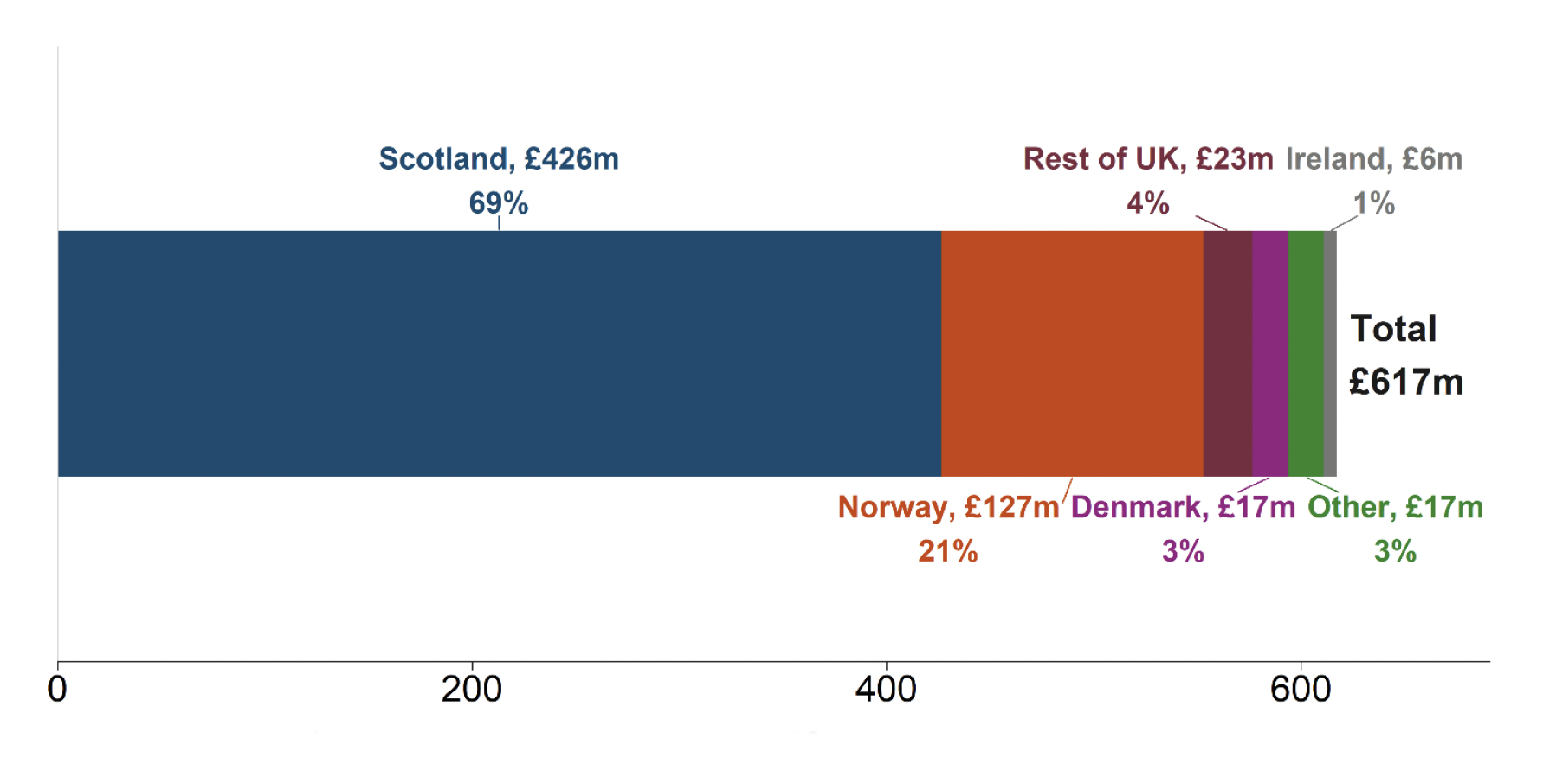
Data source: Table 4, Table 5, Table 8, Table 28.
Landings abroad accounted for 38 per cent of all landings by Scottish vessels by tonnage and 27 per cent by value. Of this, 87 per cent of the tonnage landed abroad was pelagic.
The main species landed abroad was mackerel, representing 68 per cent of the total value of fish landed abroad in 2022. There were 90 thousand tonnes of mackerel worth £113 million landed abroad, which is 52 per cent of the total tonnage and 53 per cent of the value of mackerel landed by Scottish vessels.
Norway is by far the largest destination for Scottish vessels' landings abroad, accounting for 21 per cent by value of all Scottish vessels' landings and 76 per cent by value of all landings abroad. In 2022, 81 per cent of the value of landings into Norway was for mackerel, amounting to 78 thousand tonnes with a value of £103 million.
2.6 Area of capture
Scottish vessels are most active in two main ICES areas[9] : the Northern North Sea (ICES Area IVa) and the West Coast of Scotland (ICES Area VIa).
In 2022, 277 thousand tonnes of sea fish and shellfish with a value of £393 million were landed from the Northern North Sea (IVa), representing 65 per cent of the tonnage and 64 per cent of the value of all landings by Scottish vessels (Table 31).
Fourteen per cent of landings by Scottish vessels, by tonnage were caught in the West Coast of Scotland (VIa), providing 19 per cent of the total value of all Scottish landings. Area VII accounted for 11 per cent of the tonnage of all landings and six per cent of value.
Contact
There is a problem
Thanks for your feedback